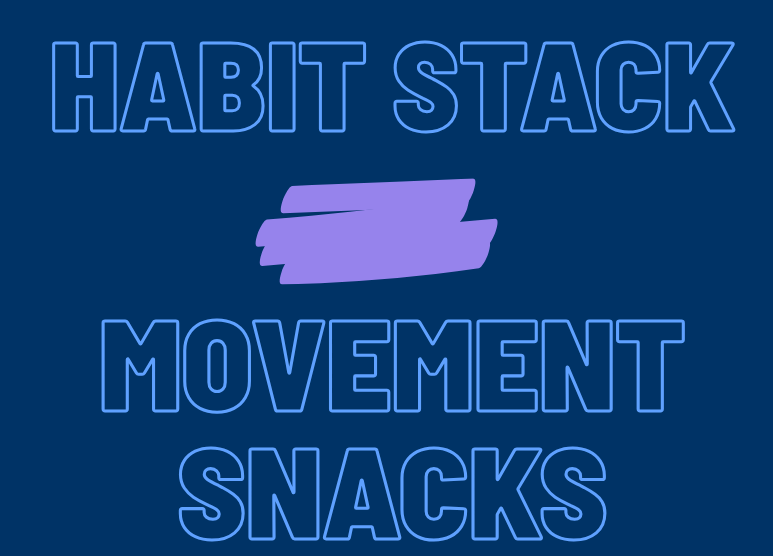Habit Stack Your Movement Snacks
Your Personalized Framework for Sitting Less and Moving More
Can you be sedentary even if you meet the recommended exercise guidelines for adults?
We walk for 30 minutes 5 times a week. We diligently get our 150 minutes of moderate-intensity cardio exercise. Maybe we even strength train 2 times a week and do some stretching and balance exercises. According to the exercise guidelines that makes us “regular exercisers.”
But even though we’ve ticked off all the exercise boxes, we might still be classified as sedentary. The harsh reality is that most of us are.
Let’s do the math. That 150 minutes breaks down to about 22 minutes per day, leaving 14+ waking hours during which most of us aren’t moving much.
So what’s the solution? Trying to “fix” a sedentary lifestyle with a single workout is like trying to hydrate for a week by chugging a gallon of water on Monday morning. It doesn’t work. The real solution is to take a sip a—movement snack—throughout your day. You need a system for continuous deposits; not a one-time lump sum.
This isn't your vanilla “move more, sit less” advice. We’re going to learn exactly how to make that movement actually happen—not through willpower or phone alarms we often ignore, but through a simple system that makes movement as automatic as brushing your teeth.
The Science Behind the Strategy
Research shows that prolonged sitting increases the risk for cardiovascular disease, diabetes, and premature death—even if you work out regularly:
A meta-analysis of 13 publications found sitting more than 8 hours a day without physical activity increased mortality risk as much as obesity or smoking.
A recent study published in the Journal of the American Heart Association (JAHA) found that older women who sat for 11.7 hours or more per day increased their risk of death by 30 percent, regardless of whether they exercised vigorously.
Our bodies are not built to remain seated for hours. Studies consistently show that even brief interruptions in sedentary time can have meaningful benefits:
Just 2 minutes of light walking every 30 minutes improves blood sugar control and reduces insulin spikes after meals.
A recent study of 400 postmenopausal women found that 1–2 minutes of standing or gentle movement every half hour can lower blood pressure and improve circulation.
Breaking up sitting time also improves energy and concentration. Recent studies show that breaking up sedentary stretches with 2–3 minutes of movement increases attention, energetic arousal, and executive function tasks by boosting cerebral blood flow and neurotransmitter activity.
This is great in theory, but we know that remembering to move consistently throughout a busy day is easier said than done.
That’s why we need a system. And that system combines two powerful, well-researched strategies: habit stacking and exercise snacking.
Combining Habit Stacking and Exercise Snacking
Habit stacking leverages what researchers call “implementation intentions”—the “if-then” planning that significantly improves follow-through. When you link a new behavior to an existing strong habit, you’re borrowing the automaticity you’ve already built. Studies by Peter Gollwitzer show that people who use this kind of specific planning are 2–3 times more likely to stick with a new habit.
Exercise snacking, which involves brief bursts of movement throughout the day, has also been shown to be effective. In one study, participants who did three 20-second stair climbs, spread throughout the day, improved their fitness as much as those doing traditional workouts. These micro-workouts require less time, feel more manageable, and often have better adherence rates.
The magic happens when you combine these two approaches: instead of relying on reminders or guilt, you create automatic triggers that make movement happen naturally throughout your day.
My Yoga Habit Stack Comeback
A year and a half ago I was lamenting how yoga had disappeared from my life. I’d practiced for years, but as life got busier, my once-regular yoga sessions became sporadic, then non-existent. While I valued yoga, the problem was that I tried to fit it into perfect 45-60 minute blocks that rarely materialized.
Then I tried something different. Instead of waiting for the ideal time slot, I started stacking a simple 5 minute yoga sequence onto my bedtime routine. I knew the key to my success would be keeping the yoga practice short and simple with poses that I could do without rolling out my mat.
My habit stack looks like this: Floss > Brush my teeth > Wash my face > Short yoga routine > Go to sleep.
I’ll admit, there are nights when I feel like skipping the yoga and going straight to bed. But it’s become such an integral part of my nighttime routine that skipping it isn’t really an option.
I started habit stacking stretching and yoga into my nightly routine over a year ago. And I haven’t missed more than a handful of nights since.
Yoga and stretching before bed has become as automatic as brushing my teeth. The habit is so ingrained that I can’t go to sleep without doing at least a few poses and stretches. It's fully modifiable, so even when I'm tired, I still do something. Just as I wouldn't go to bed without brushing my teeth, I don't go to bed unless I've done some pre-bedtime stretching.
This taught me something profound: the power isn’t in the perfect practice, it’s in the consistent trigger.
Your Personal Movement Snack Framework
Here’s how to design movement snacks that actually stick, customized to your life and preferences:
Step 1: Map Your Anchor Points
Start by identifying your most consistent daily habits—the things you do automatically without thinking. These become your movement triggers. Look for:
Morning anchors: Making coffee, brushing teeth, feeding pets.
Work transitions: Opening your laptop, starting lunch break, ending meetings.
Evening rituals: Cooking dinner, watching TV, getting ready for bed.
The strongest anchors are the ones you’ve done consistently for years—those are your rock-solid triggers.
Step 2: Match Movement to Context
Not every movement works in every situation. Consider your constraints:
Physical space: Jumping jacks in a cubicle? Probably not. Calf raises under your desk? Perfect.
Clothing: Wall push-ups in business attire? Feasible. Burpees in a suit? Less so.
Energy levels: Morning may call for energizing moves like arm circles or brisk walking. Evening favors calming stretches.
Time available: Coffee brewing (4 minutes), computer booting (2 minutes), commercial breaks (30 seconds).
Step 3: Discover Your Movement Personality
Think about what feels most natural to you:
Stretchers crave relief from tightness → try shoulder rolls, spinal twists, or toe touches.
Strengtheners want power and tone → try squats, wall push-ups, or stair climbs.
Shakers prefer energizing motion → try marching in place, arm circles, or dancing.
Soothers need calm and grounding → try slow breathing, neck stretches, or gentle forward folds.
The right choice is the one that feels good and sustainable for your body.
Step 4: Start Ridiculously Small
Make your movement snack so easy it feels silly not to do it. We’re building neural pathways, not training for a marathon.
Examples:
3 shoulder rolls after sitting down at your desk.
5 calf raises while the coffee brews.
10 seconds of neck stretches after closing your laptop.
1 wall push-up before entering the bathroom.
The goal isn’t the perfect exercise—it’s wiring the trigger-movement connection. Expansion usually happens naturally.
Step 5: Test and Iterate
Try one pairing for a week, then check in:
Did you remember it most days?
Did it feel natural or forced?
Do you want to continue this combination?
If it’s not working, adjust either the trigger (after coffee vs. while coffee brews) or the movement (arm circles instead of shoulder rolls).
The Long Game
The beauty of movement snacks is that they provide immediate health benefits. And they also retrain your brain to associate movement with daily life rather than treating exercise as a separate event that needs special time, clothes, or motivation.
After a year of my bedtime yoga habit, I’ve noticed something interesting: I naturally incorporate more movement snacks throughout my day. This single habit stack didn’t just build one routine; it created a ripple effect, making other small movements feel effortless and intuitive.
This is about more than just doing a few calf raises here and there. It’s about changing your relationship with movement from something you have to schedule to something you simply do.
So what’s one small movement snack you’ll stack onto an existing habit this week? Your thoughts and ideas can help the rest of us.
If you missed my previous post on how I habit stacked my yoga routine into my nighttime routine, here’s the link.
💙 If my posts help you feel more informed and in control of your well-being, please consider joining our community of paid subscribers. Your support is a direct investment in the creation of more thoughtful, science-backed content that empowers you to add life to your years.





Before taking this class and reading this article, I always thought that doing my morning workout would check off my exercise box and I was able to relax and not get that much exercise for the rest of the day. I thought my actions for the rest of the day did not matter do to the fact that I already accomplished my 60 minute morning workout. Now I know that when I get home from the gym I should not sit down and do homework and watch tv for 6 hours straight, instead I should be breaking up sitting with getting up and walking every 30 minutes or so. I can also stand up to do homework and find more creative ways to be less sedentary. Doing so will greatly impact my life and set myself up for a better future just by doing these small changes. I also like the idea that adding in small changes such as small movements while sitting down or being sedentary is so important and it doesn't even feel like you are exercising.
Sitting is the new smoking.
Heard that before? That is more than a cliche.
Daria shows in her excellent article how we all can integrate short, but frequent bouts of exercise into our day, so we not only work against premature death, but have more energy, a better focus and mood.
Exercise alone won`t save you - your article not only shows why, but it gives actionable tipps on how to "eat" more movement snacks and thereby counteract the devastating effects of prolonged sitting.